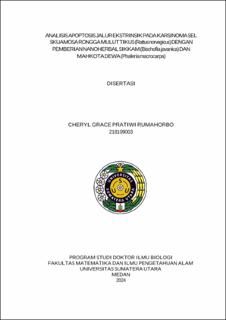| dc.description.abstract | Oral squamous cell carcinoma (OSCC) is a common type of cancer in the head and
neck region, particularly prevalent in Southeast Asia due to the consumption of
tobacco with betel and areca nuts. In tobacco, Benzo(alpha)pyrene (BaP) is associated
with Aryl Hydrocarbon Receptor activation, oxidative damage, and DNA mutations
that trigger uncontrolled cancer cell growth. This research aims to analyze the
administration of nano-herbs sikkam and mahkota dewa in combination with the
expression of extrinsic apoptosis pathway proteins in OSCC rats. Nano-herb sikkam
and mahkota dewa are used to induce apoptosis in OSCC. Nano-herbs were prepared
using the High Energy Milling (HEM) method and analyzed using Scanning Electron
Microscopy (SEM), Particle Size Analysis (PSA), phytochemical screening,
characteristic testing, and toxicity testing. The OSCC rat model was established by
injecting BaP at 0.04 mg/0.04 ml corn oil into the right buccal mucosa three times a
week for four weeks. The study consisted of six groups: normal rats, OSCC rats, OSCC
rats treated with nano-herb sikkam, OSCC rats treated with nano-herb mahkota dewa,
OSCC rats treated with a combination of nano-herb sikkam and mahkota dewa, and
OSCC rats treated with vitamin C. Nano-herb sikkam (800 mg/kgBW), nano-herb
mahkota dewa (500 mg/kgBW), their combination, and vitamin C (40 mg/kgBW) were
administered from week 6 to week 9 once daily. The ELISA technique was employed
to analyze MDA, SOD, and VEGF levels in blood serum. Immunohistochemical
staining was performed to analyze the expression of MDA, HSP-70, Caspase-8,
Caspase-10, and Caspase-3 in cancer tissues. Results of SEM revealed that nano-herb
sikkam particles had a size of 6 nm and mahkota dewa had a size of 7.7 nm, with
complex surfaces and crystalline structures. PSA results showed a reduction in the size
of sikkam particles from 7084.8 nm to 188.8 nm and mahkota dewa from 5062.5 nm
to 246.5 nm. Qualitative phytochemical screening confirmed that both nano-herbs
contained flavonoids, terpenoids, steroids, and saponins. Characteristic testing
indicated that both materials met the standards of the Indonesian Herbal
Pharmacopoeia for herbal drug development. Toxicity testing confirmed that both
materials were categorized as mildly toxic. The combination of nano-herb mahkota
dewa and sikkam significantly reduced MDA and VEGF levels, increased SOD levels,
and stimulated the expression of HSP-70, Caspase-8, Caspase-10, and Caspase-3.
These herbal compounds promoted apoptosis through caspase-3 with flavonoids that
activated caspase-8 and caspase-10 as a caspase initiator. | en_US |


